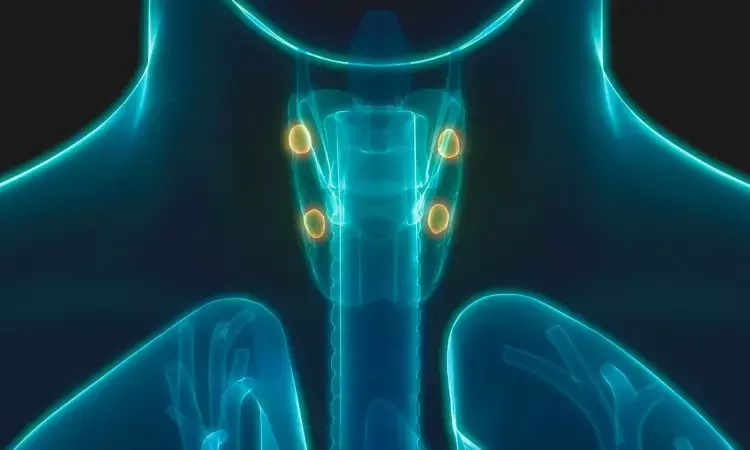- Home
- Medical news & Guidelines
- Anesthesiology
- Cardiology and CTVS
- Critical Care
- Dentistry
- Dermatology
- Diabetes and Endocrinology
- ENT
- Gastroenterology
- Medicine
- Nephrology
- Neurology
- Obstretics-Gynaecology
- Oncology
- Ophthalmology
- Orthopaedics
- Pediatrics-Neonatology
- Psychiatry
- Pulmonology
- Radiology
- Surgery
- Urology
- Laboratory Medicine
- Diet
- Nursing
- Paramedical
- Physiotherapy
- Health news
- Fact Check
- Bone Health Fact Check
- Brain Health Fact Check
- Cancer Related Fact Check
- Child Care Fact Check
- Dental and oral health fact check
- Diabetes and metabolic health fact check
- Diet and Nutrition Fact Check
- Eye and ENT Care Fact Check
- Fitness fact check
- Gut health fact check
- Heart health fact check
- Kidney health fact check
- Medical education fact check
- Men's health fact check
- Respiratory fact check
- Skin and hair care fact check
- Vaccine and Immunization fact check
- Women's health fact check
- AYUSH
- State News
- Andaman and Nicobar Islands
- Andhra Pradesh
- Arunachal Pradesh
- Assam
- Bihar
- Chandigarh
- Chattisgarh
- Dadra and Nagar Haveli
- Daman and Diu
- Delhi
- Goa
- Gujarat
- Haryana
- Himachal Pradesh
- Jammu & Kashmir
- Jharkhand
- Karnataka
- Kerala
- Ladakh
- Lakshadweep
- Madhya Pradesh
- Maharashtra
- Manipur
- Meghalaya
- Mizoram
- Nagaland
- Odisha
- Puducherry
- Punjab
- Rajasthan
- Sikkim
- Tamil Nadu
- Telangana
- Tripura
- Uttar Pradesh
- Uttrakhand
- West Bengal
- Medical Education
- Industry
Parathyroidectomy Lowers Diabetes Risk in PHPT, Especially in Younger and Severe Cases: JAMA

A new study published in the Journal of American Medical Association showed that patients with primary hyperparathyroidism (PHPT) who undergo a parathyroidectomy had a lower chance of acquiring diabetes; the benefits are greater in younger patients and those with more advanced illness, indicating that the procedure has additional metabolic benefits.
Excess parathyroid hormone secretion is a common endocrine condition known as primary hyperparathyroidism, which can result in hypercalcemia and metabolic problems. Growing data points to a possible connection between PHPT and abnormalities in glucose metabolism, like insulin resistance and the risk of diabetes, in addition to its effects on the skeleton and kidneys.
The last therapy for PHPT, parathyroidectomy, may have an impact on long-term metabolic outcomes in addition to returning calcium and parathyroid hormone levels to normal. Thus, this study investigated the independent relationship between parathyroidectomy and incident diabetes risk in PHPT patients.
Using a Hong Kong territory wide electronic health database, patients with PHPT diagnosed between January 2006 and December 2023 were categorized into surgical and nonsurgical groups according to whether they had undergone a later parathyroidectomy.
The patients were monitored from the index date (the initial PHPT diagnosis) until the conclusion of the research period (December 2023), the result of interest (the incident diabetes), or their death, whichever occurred first. Incident diabetes was the study's main endpoint. All baseline attributes were balanced using inverse probability of treatment weighting.
There were 3135 PHPT patients in total (596 [19.0%] were surgical and 2539 [81.0%] were nonsurgical). 2211 (70.5%) of the participants were female, and the mean (SD) age was 67.5 (14.2) years.
During a median (IQR) follow-up of 2.2 (0.9-4.3) years, incident diabetes occurred in 518 patients in the nonsurgical group and 156 patients in the surgical group during a median (IQR) follow-up of 5.5 (3.3-8.0) years. A decreased incidence of onset diabetes was linked to parathyroidectomy (hazard ratio [HR], 0.68 [95% CI, 0.65-0.71]; P <.001). Several sensitivity studies yielded consistent results.
Subgroup analyses showed stronger advantageous associations among young patients (age ≤65 years vs >65 years: HR, 0.64 [95% CI, 0.60-0.68] vs HR, 0.68 [95% CI, 0.63-0.72]; interaction P <.001) and those with more serious PHPT (calcium > 2.8 vs calcium ≤ 2.8 mmol/L: HR, 0.58 [95% CI, 0.54-0.63] vs HR, 0.69 [95%CI, 0.66-0.73]; interaction P <.001).
Overall, a decreased incidence of incident diabetes was linked to parathyroidectomy in this group of PHPT patients. Younger patients and those with more severe PHPT showed a stronger correlation. These findings could point to possible extra metabolic advantages of parathyroidectomy in PHPT.
Reference:
Liu, X., Lui, D. T. W., Xiong, X., Li, L., Luk, Y., Wong, C. H., Lee, C. H., Wong, C. K. H., Fung, M. M. H., & Lang, B. H. H. (2025). Parathyroidectomy and risk of incident diabetes in patients with primary hyperparathyroidism. JAMA Surgery. https://doi.org/10.1001/jamasurg.2025.3081
Neuroscience Masters graduate
Jacinthlyn Sylvia, a Neuroscience Master's graduate from Chennai has worked extensively in deciphering the neurobiology of cognition and motor control in aging. She also has spread-out exposure to Neurosurgery from her Bachelor’s. She is currently involved in active Neuro-Oncology research. She is an upcoming neuroscientist with a fiery passion for writing. Her news cover at Medical Dialogues feature recent discoveries and updates from the healthcare and biomedical research fields. She can be reached at editorial@medicaldialogues.in
Dr Kamal Kant Kohli-MBBS, DTCD- a chest specialist with more than 30 years of practice and a flair for writing clinical articles, Dr Kamal Kant Kohli joined Medical Dialogues as a Chief Editor of Medical News. Besides writing articles, as an editor, he proofreads and verifies all the medical content published on Medical Dialogues including those coming from journals, studies,medical conferences,guidelines etc. Email: drkohli@medicaldialogues.in. Contact no. 011-43720751


